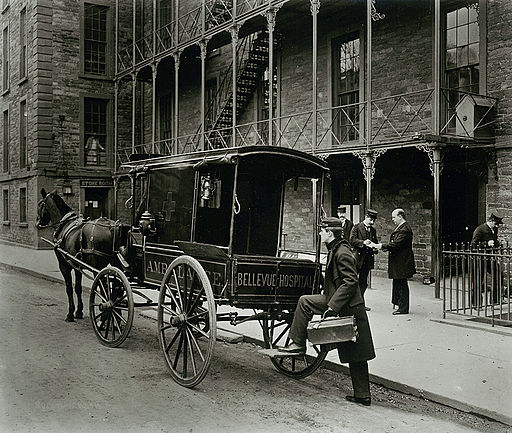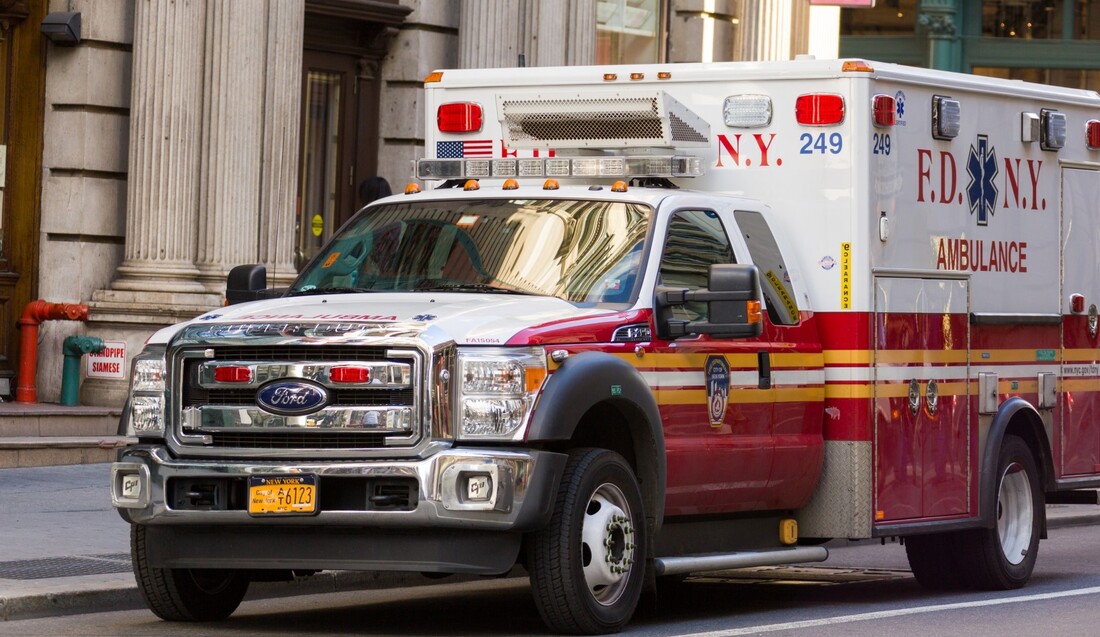|
By Laurie Lewis Ambulances have been fixtures on the streets of New York since 1869, when Bellevue Hospital started the nation’s second ambulance service. (Commercial Hospital in Cincinnati had one four years earlier.) A Bellevue staff surgeon, Edward B. Dalton, had handled transport of wounded soldiers during the Civil War, and he adapted his wartime experience for the quick movement of ill and injured city dwellers. The ambulance was primitive by today’s standards: a horse-drawn vehicle with a gong to clear a path through the congested streets of Manhattan, equipped with basic first-aid material as well as brandy to relieve pain. Bellevue Hospital Ambulance, 1895 At least one doctor rode in the Bellevue ambulance. By the 1930s, that doctor was an intern near the end of his first year. Motorized ambulances had replaced horse-drawn wagons, but the ride still wasn’t very comfortable. Writing in a 1999 Journal of Urban Health, Dr. Morton Galdston recalled his month of ambulance duty 60 years earlier. He had to hang on to a leather strap to keep from falling off a hard wooden bench, and the reward at the end of his stint was a sore butt. During that month, he went on 384 calls, including 41 for inebriated men and women (in those days, alcoholics were taken to Bellevue, to protect both them and the city), 32 for people injured in falls, and 26 for children with measles. Dr. Galdston saw only 17 cases each of heart disease and lower respiratory tract illness, critical conditions that account for many of today’s ambulance calls. Since 1996, the New York Fire Department (FDNY) has been in charge of the city’s Emergency Medical Services (EMS). Most of the ambulances responding to calls to the city’s 911 system are FDNY EMS units, but 30% are hospital-based units (like the old Bellevue rig). Emergency medical technicians (EMTs) staff the basic life support ambulances, where they can perform cardiopulmonary resuscitation (CPR), administer oxygen, stabilize fractures, and assist in childbirth. More highly trained paramedics ride the advanced life support ambulances, where they care for severely ill or injured patients and administer medications, if needed. The 4,400 EMTs and paramedics usually work in pairs. Depending on the nature of the emergency, multiple vehicles—including both a basic and an advanced life support ambulance, as well as a fire engine with firefighters trained in CPR—might respond to a 911 call. Modern-day Ambulance Last spring, when New York City was the epicenter of the nation’s coronavirus pandemic, the number of EMS calls soared from an average of 4,000 a day to more than 7,000. At the same time, 40% of EMS staff were on medical leave for suspected or confirmed COVID-19, and they stayed out an average of 20 to 25 days. To manage the strain on resources, the lifesavers who ride in the ambulances received orders to change the way they respond to heart attacks. Only one ambulance, an advanced life support rig, would come to the scene. A patient who did not respond to CPR would be pronounced dead rather than transported to the hospital for further resuscitation efforts. Later, when the coronavirus epicenter shifted to Los Angeles, the EMS system there issued similar no-transport orders for patients who did not respond to CPR in the field. Sadly, COVID-19 has already taken the lives of four FDNY EMTs, one hospital-based paramedic, and one FDNY ambulance mechanic. Stressed by the disease that they encountered in staggering numbers, three other EMS members committed suicide. Still mourning the loss of their colleagues, the EMTs and paramedics who staff New York’s ambulances continue to come to the aid of the city’s grateful residents. Jewish Ambulance Services In 1969, a Brooklyn rabbi, Hershel Weber, organized fellow Orthodox Jews to create a volunteer ambulance service. Hatzalah, as the service is called, spread across the city and far beyond, now ranking as one of the largest volunteer ambulance services in the world. The Hatzalah volunteers understand religious laws, customs, and restrictions, easing the stress of their ill and injured neighbors. Because of its unique dispatch system, Hatzalah often arrives on the scene before FDNY EMS. The first to get there usually are EMTs who come in privately owned vehicles equipped with emergency lighting and basic life-saving paraphernalia. Meanwhile, other volunteers retrieve a Hatzalah ambulance and join the rescuers. Modesty being a basic tenet of their culture, women in Brooklyn’s Orthodox community sometimes feel uncomfortable with Hatzalah’s all-male EMTs and paramedics. In 2013, Rachel Freier, who is now a Brooklyn Civil Court judge—a first for a Hasidic woman—founded Ezras Nashim, an all-female counterpart of Hatzalah. For years, Ezras Nashim could not get an ambulance license, forcing the EMTs to use only their own vehicles and barring them from transporting patients to the hospital. Last August, the New York State EMS Council reversed an earlier decision against Ezras Nashim. The female volunteers proudly introduced their new ambulance in October—just in time for the second wave of the COVID-19 pandemic in New York. Tours
Scheduled tours are suspended during the coronavirus pandemic. If you would like ideas for private tours, please see our website. Comments are closed.
|
Archives
April 2024
|



